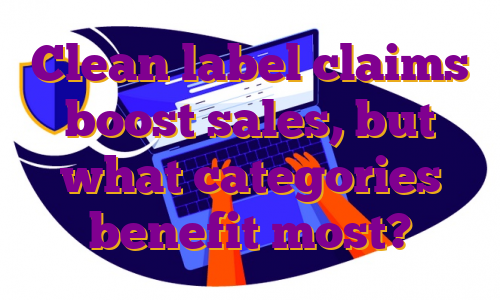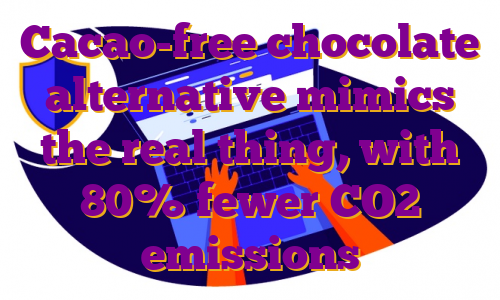The clean label ingredient market is expected to grow to a value of US$42.5bn globally, according to forecasters at Market Research Future. That represents an impressive CAGR of over 17.5% through to the end of the decade.Product formulators are working on innovation and renovation that replaces artificial ingredients with those that are perceived as natural and minimally processed. Simplicity strikes a chord and shorter, understandable ingredient lists remain in vogue.This isn’t a new trend. The industry has been talking about the importance of cleaning up product labels for years. A recent study from Ingredion revealed that globally at least 50% of manufacturers report that their portfolios have already converted to clean label formulations. But manufacturers also said they have plans to increase clean label efforts in the next two-to-three years. So why do efforts to convert to clean label continue to gain steam?Consumers willing to pay more for clean labelsIngredion’s Global Clean Label Manufacturer research revealed that around 71% of consumers are willing to pay more for current brands that have been reformulated to make claims around the naturalness of their ingredients. Over 30% of consumers would be willing to pay a premium of more than 20%.While brands that convert to cleaner labels may be able to reap the rewards, those that do not risk being punished, with 82% of global consumers reporting a ‘high likelihood’ of switching from current brands not offering these claims to new brands that have these benefits. What’s more, 70% of them would not only switch but pay more to do so.This statement of intent is also borne out in what manufacturers are reporting on the ground, with 58% of food and beverage brands suggesting they have benefited from an increase in overall revenue thanks to conversion to clean label formulations.“Consumers are willing pay for additional benefits in current brands and new brands. Current brands are at risk of attrition and missed revenue opportunities if manufacturers do not convert their offerings and remain static,” Ingredion’s Daniel Haley, global Clean & Simple platform lead, told FoodNavigator. “These results make it easier to understand why over 50% over respondents said offering clean label foods or beverages is a priority within their company’s overall business strategy.” What motivates consumers to pay more for clean labels? Caution and health / Pic: GettyImages-Iam AnupongClean label resonates in categories with health halo and risk perceptionMarket Research Future analysts point out that the COVID-19 pandemic has had a ‘massive impact’ on the worldwide market for clean label ingredients. The researchers suggest clean label conversion is underpinned by two consumer drivers: caution about any negative health impact of food ingredients and demand for healthy options.“The buying habits of the consumers have changed notably, with them being more cautious about the food products that they purchase. Healthy eating habits have become quite prevalent among consumers…. Consumers are increasingly focusing on clean labels for out-of-home and at-home purchases; therefore, enhancing the application scope of clean label ingredients in a variety of food products,” they wrote in a research report.Perceived benefits around wellness are the primary driver for clean label demand, Ingredion’s Haley believes. “Whilst today’s consumers may also be looking for new, targeted health benefits or products supporting particular elements of sustainability, their foundational expectation is that products are made with ingredients they recognise, accept and strongly associate with naturality and minimal processing. Clean label is their first priority,” he stressed.So, what categories can benefit most from clean label renovation?When it comes to willingness to pay more and switch to brands with clean label credentials, Ingredion found all categories benefit – but some more so than others. Segments that are already associated with a health-halo and products aimed at children stand to gain most from clean label claims, while fixtures viewed as less healthy or more indulgent resonated less, Ingredion found.“The categories where the largest percentage of consumers will pay 20-30% more for products include baby food, meat and meat alternatives, plant-based yogurts, and plant-based milks. A lower percentage of consumers would pay such a premium in carbonated soft drinks and energy drinks. We tend to see lower desire in categories that are considered more of an indulgence or not usually considered a vehicle for health,” Haley detailed.
What motivates consumers to pay more for clean labels? Caution and health / Pic: GettyImages-Iam AnupongClean label resonates in categories with health halo and risk perceptionMarket Research Future analysts point out that the COVID-19 pandemic has had a ‘massive impact’ on the worldwide market for clean label ingredients. The researchers suggest clean label conversion is underpinned by two consumer drivers: caution about any negative health impact of food ingredients and demand for healthy options.“The buying habits of the consumers have changed notably, with them being more cautious about the food products that they purchase. Healthy eating habits have become quite prevalent among consumers…. Consumers are increasingly focusing on clean labels for out-of-home and at-home purchases; therefore, enhancing the application scope of clean label ingredients in a variety of food products,” they wrote in a research report.Perceived benefits around wellness are the primary driver for clean label demand, Ingredion’s Haley believes. “Whilst today’s consumers may also be looking for new, targeted health benefits or products supporting particular elements of sustainability, their foundational expectation is that products are made with ingredients they recognise, accept and strongly associate with naturality and minimal processing. Clean label is their first priority,” he stressed.So, what categories can benefit most from clean label renovation?When it comes to willingness to pay more and switch to brands with clean label credentials, Ingredion found all categories benefit – but some more so than others. Segments that are already associated with a health-halo and products aimed at children stand to gain most from clean label claims, while fixtures viewed as less healthy or more indulgent resonated less, Ingredion found.“The categories where the largest percentage of consumers will pay 20-30% more for products include baby food, meat and meat alternatives, plant-based yogurts, and plant-based milks. A lower percentage of consumers would pay such a premium in carbonated soft drinks and energy drinks. We tend to see lower desire in categories that are considered more of an indulgence or not usually considered a vehicle for health,” Haley detailed. What categories will consumers pay for clean labels in? / Pic: GettyImages-Tom WernerThe baby food category stands as an example of clean label expectations being enhanced by consumer caution. High demand for clean labels in baby food stems from parents’ desire to ensure their babies get the best nutritional start and, significantly, to protect them from ingredients that could be considered harmful.The Clean Label Project, a US advocacy group, is pushing for greater scrutiny of what goes into baby food and recently launched a certification scheme in response to the presence of contaminants like heavy metals that have been detected in the segment.“The First 1,000 Day standard shifts the narrative when it comes to ‘baby food’ safety. The standard is applicable to not just traditional baby foods but all foods and ingredients marketed towards pregnant women, infants, children, and lactating mothers,” explained Dr. Stephanie Canale, family medicine physician and member of the Clean Label Project Technical Advisory Committee.“There is an inextricable link between the health of the mother and her child. Infants and children have unique nutritional needs and unique vulnerabilities. Parents, brands, and governments alike should take every possible precaution to assure the health and safety of this most vulnerable population. The best way to decrease exposure to any given contaminant is to strive for variety in the foods given to babies and toddlers.”Plant-based products, meanwhile, are often perceived as healthier alternatives. But formulators in the space face a particular challenge around mimicking the organoleptic properties of animal-based products while meeting clean label expectations.
What categories will consumers pay for clean labels in? / Pic: GettyImages-Tom WernerThe baby food category stands as an example of clean label expectations being enhanced by consumer caution. High demand for clean labels in baby food stems from parents’ desire to ensure their babies get the best nutritional start and, significantly, to protect them from ingredients that could be considered harmful.The Clean Label Project, a US advocacy group, is pushing for greater scrutiny of what goes into baby food and recently launched a certification scheme in response to the presence of contaminants like heavy metals that have been detected in the segment.“The First 1,000 Day standard shifts the narrative when it comes to ‘baby food’ safety. The standard is applicable to not just traditional baby foods but all foods and ingredients marketed towards pregnant women, infants, children, and lactating mothers,” explained Dr. Stephanie Canale, family medicine physician and member of the Clean Label Project Technical Advisory Committee.“There is an inextricable link between the health of the mother and her child. Infants and children have unique nutritional needs and unique vulnerabilities. Parents, brands, and governments alike should take every possible precaution to assure the health and safety of this most vulnerable population. The best way to decrease exposure to any given contaminant is to strive for variety in the foods given to babies and toddlers.”Plant-based products, meanwhile, are often perceived as healthier alternatives. But formulators in the space face a particular challenge around mimicking the organoleptic properties of animal-based products while meeting clean label expectations.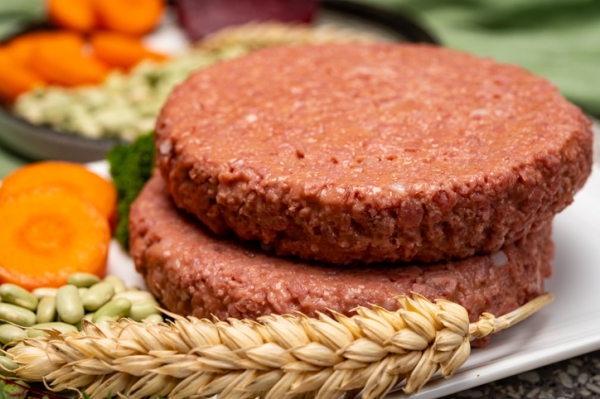 It can be difficult to produce a meaty mouthfeel while keeping labels clean / Pic: GettyImages-BarmaliniAccording to European organic ingredient supplier AGRANA Group this difficulty is clearly evident in vegan meat substitutes, where formulations that are free of additives – particularly artificial emulsifiers such as methyl cellulose – can be difficult to deliver while producing a meat-like juicy mouthfeel.At the AGRANA Research and Innovation Centre in Austria, the company is exploring potential solutions, creating vegan burger patties using ingredients like pre-gelatinized maize starch, potato fibres and vital wheat gluten, which – it claimed – ‘completely replace’ the need for methyl cellulose. “As a processor of plant-based, agricultural raw materials, we aim to show our customers how we can address the demand for vegan and vegetarian nutrition with new sustainable concepts,” reflected CEO Markus Mühleisen.Clean label and sugar reductionIf product categories that are already perceived as healthy benefit from clean label innovation, what about product attributes linked to health?Reduced or low sugar claims probably stand at the forefront of this, with research showing sugar content is a key influencer for the majority of grocery shoppers. However, sugar reduction has a nuanced relationship to clean label demand – sugar is, after all, a natural ingredient.A recent study sponsored by Cargill suggests that while consumers frequently check the amount of sugar a product contains before they purchase, they are less likely to scrutinise the specific sweetener used. Does this mean reduced-sugar products are exempt from the need to deliver clean labels? Not exactly, Cargill stressed.
It can be difficult to produce a meaty mouthfeel while keeping labels clean / Pic: GettyImages-BarmaliniAccording to European organic ingredient supplier AGRANA Group this difficulty is clearly evident in vegan meat substitutes, where formulations that are free of additives – particularly artificial emulsifiers such as methyl cellulose – can be difficult to deliver while producing a meat-like juicy mouthfeel.At the AGRANA Research and Innovation Centre in Austria, the company is exploring potential solutions, creating vegan burger patties using ingredients like pre-gelatinized maize starch, potato fibres and vital wheat gluten, which – it claimed – ‘completely replace’ the need for methyl cellulose. “As a processor of plant-based, agricultural raw materials, we aim to show our customers how we can address the demand for vegan and vegetarian nutrition with new sustainable concepts,” reflected CEO Markus Mühleisen.Clean label and sugar reductionIf product categories that are already perceived as healthy benefit from clean label innovation, what about product attributes linked to health?Reduced or low sugar claims probably stand at the forefront of this, with research showing sugar content is a key influencer for the majority of grocery shoppers. However, sugar reduction has a nuanced relationship to clean label demand – sugar is, after all, a natural ingredient.A recent study sponsored by Cargill suggests that while consumers frequently check the amount of sugar a product contains before they purchase, they are less likely to scrutinise the specific sweetener used. Does this mean reduced-sugar products are exempt from the need to deliver clean labels? Not exactly, Cargill stressed.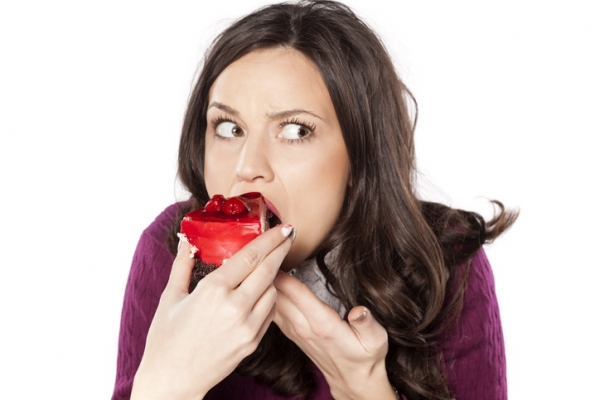 Do shoppers want clean-label reformulation to cut sugar? / Pic: GettyImages-VladamirFLloydThe company’s 2021 survey of US shoppers also found evidence that sweetener claims influence purchases, too. Those that fared best in the Cargill study typically implied ‘natural’ or ‘no artificial’, including ‘naturally sweetened’ or ‘made with a natural sweetener’.Carla Saunders, senior marketing manager for Cargill’s high intensity sweetener lines, believes that clean label claims in reduced sugar products became more important for consumers in the wake of the pandemic.“The popularity of these types of claims – especially sugar-reduction – have been amplified by COVID-19, building on the ‘clean eating’ trends we’ve been tracking for several years,” she explained.“Products with these on-pack labels are often perceived as less processed and more healthful. That aligns with the demands of today’s more health-conscious consumers, who are seeking to manage their health and wellness goals through food and beverage choices.” .
Do shoppers want clean-label reformulation to cut sugar? / Pic: GettyImages-VladamirFLloydThe company’s 2021 survey of US shoppers also found evidence that sweetener claims influence purchases, too. Those that fared best in the Cargill study typically implied ‘natural’ or ‘no artificial’, including ‘naturally sweetened’ or ‘made with a natural sweetener’.Carla Saunders, senior marketing manager for Cargill’s high intensity sweetener lines, believes that clean label claims in reduced sugar products became more important for consumers in the wake of the pandemic.“The popularity of these types of claims – especially sugar-reduction – have been amplified by COVID-19, building on the ‘clean eating’ trends we’ve been tracking for several years,” she explained.“Products with these on-pack labels are often perceived as less processed and more healthful. That aligns with the demands of today’s more health-conscious consumers, who are seeking to manage their health and wellness goals through food and beverage choices.” .
Cacao-free chocolate alternative mimics the real thing, with 80% fewer CO2 emissions
Chocolate is one of the most consumed food products on the planet. Estimated to reach a total market size of $180bn by 2025, according to ResearchAndMarkets, chocolate is big business.But the chocolate industry has a ‘truly dark side’, according to London-based start-up WNWN (pronounced ‘win-win’) Food Labs. “People don’t really know about the problems that go into that delicious treat they have at the end of the day,” WNWN co-founder and CEO Ahrum Pak explained.“In summary, there is climate change, there is deforestation, and the supply chain is rife with child labour and slave labour – typically around Cote d’Ivoire and Ghana where 70-80% of the world’s supply comes from.”Just as plant-based innovators are replacing conventional proteins with meat alternatives, so is WNWN looking to swap out conventional chocolate with a cacao-free substitute.The result is an ‘alt chocolate’ product that is caffeine free, lower in sugar, and responsible for 80% fewer CO2 emissions than comparable products, we were told.How do you make ‘alt choc’?WNWN’s process is founded on traditional fermentation techniques. Not only because almost ‘everything that is fermented tastes good’, said Pak (think wine, beer, and kombucha), but because chocolate is also a fermented product.To make chocolate, cacao beans are fermented and then roasted, before being processed into the final product. Instead of using cacao, WNWN makes its chocolate alternative from two ‘hero ingredients’: barley and carob.Barley is an ‘incredible grain’ that humans have been consuming in bread and alcohol for several thousands of years, WNWN co-founder and CTO Dr Johnny Drain told FoodNavigator. “It has a very rich culinary tradition in the British Isles and elsewhere.”Leaning on traditional fermentation techniques and modern-day food science, the start-up is ‘transforming’ barley into a product that is ‘mega chocolatey’, he continued.The fermented barley is then coupled with carob – an ingredient with a somewhat weaker culinary tradition in the western world. In the UK, carob was employed as a ‘healthy’ alternative to chocolate a few decades ago, but it never really took off. “It was in the health and organic food scenes, but historically [food makers] just didn’t quite nail it.”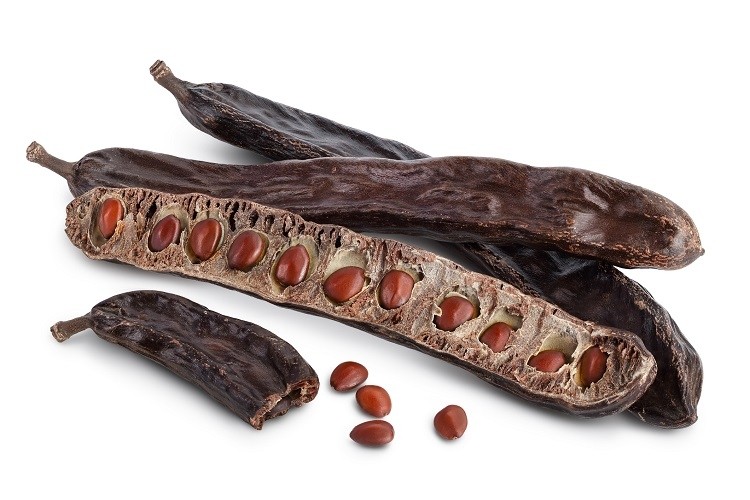 Carob is one of the key ingredients in WNWN’s product. GettyImages/kolesnikovsergHowever, carob is chocolatey, stressed the CTO, and the combination of carob and fermented barley makes for a ‘deliciously chocolatey profile’. WNWN’s carob is grown in Spain and Italy and is certified organic. “Production of carob is very sustainable and not mired by the sorts of deforestation problems that cacao is,” said Dr Drain.Without cacao, there is no cocoa butter. Instead WNWN is sourcing shea fat from Ghana.“All the ingredients we are sourcing and sustainable, organic, and high-quality,” said Pak. “We’ve gone to several lengths to ensure our supply is so. We’re looking to create long-lasting relationships with local farmers.”Nutritional and flavour profile for humans…and doggos!The start-up’s first product is a dairy-free premium dark chocolate alternative. Its nutritional profile is ‘very similar’ to conventional chocolate – albeit containing slightly less sugar.While the product’s full flavonoid and antioxidant profiles are not yet fully understood by WNWN, it plans to investigate its potential health benefits.One obvious upside of WNWN’s product, compared to chocolate, will be appreciated by consumers’ four-legged friends, suggested Dr Drain. Dogs cannot eat conventional chocolate due to its theobromine content, which they are unable to metabolise effectively.WNWN’s alt choc does not contain theobromine. “Your doggo can eat our chocolate,” said the CTO. “We’ve tested it on some dogs…and they absolutely go wild for it.”
Carob is one of the key ingredients in WNWN’s product. GettyImages/kolesnikovsergHowever, carob is chocolatey, stressed the CTO, and the combination of carob and fermented barley makes for a ‘deliciously chocolatey profile’. WNWN’s carob is grown in Spain and Italy and is certified organic. “Production of carob is very sustainable and not mired by the sorts of deforestation problems that cacao is,” said Dr Drain.Without cacao, there is no cocoa butter. Instead WNWN is sourcing shea fat from Ghana.“All the ingredients we are sourcing and sustainable, organic, and high-quality,” said Pak. “We’ve gone to several lengths to ensure our supply is so. We’re looking to create long-lasting relationships with local farmers.”Nutritional and flavour profile for humans…and doggos!The start-up’s first product is a dairy-free premium dark chocolate alternative. Its nutritional profile is ‘very similar’ to conventional chocolate – albeit containing slightly less sugar.While the product’s full flavonoid and antioxidant profiles are not yet fully understood by WNWN, it plans to investigate its potential health benefits.One obvious upside of WNWN’s product, compared to chocolate, will be appreciated by consumers’ four-legged friends, suggested Dr Drain. Dogs cannot eat conventional chocolate due to its theobromine content, which they are unable to metabolise effectively.WNWN’s alt choc does not contain theobromine. “Your doggo can eat our chocolate,” said the CTO. “We’ve tested it on some dogs…and they absolutely go wild for it.”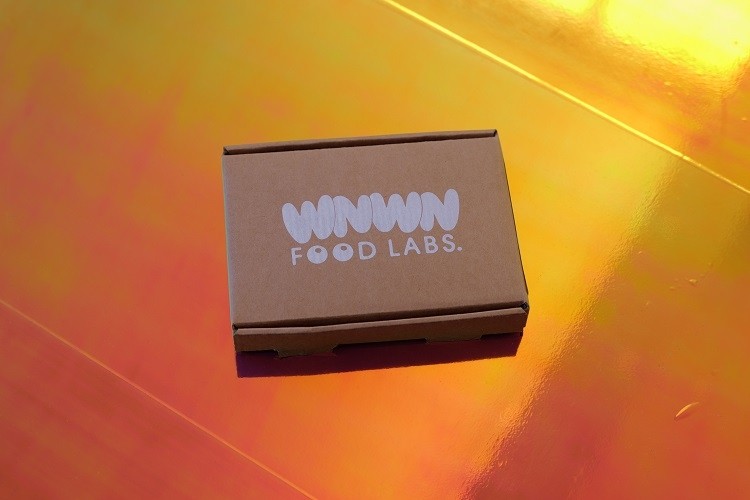 WNWN’s premium dark chocolate product is made from two ‘hero ingredients’: barley and carob. Image source: WNWNSo does WNWN’s alt choc product taste like chocolate? “We’re trying to replicate the experience of chocolate,” the CTO explained.In terms of flavour, the start-up has achieved the archetypal bitterness associated with dark chocolate, as well as its ‘fruity acidity’. “We have red berries, prunes, notes of butterscotch in the long finish and a maltiness coming through from the barley.”“It’s a flavour profile that is very similar to that of premium dark chocolate: lots of acidity and brightness, complexity, and bitterness.”WNWN is working on an alternative to milk chocolate which is more ‘neutral’ in flavour, making for a ‘creamy’ experience with less acidity.The experience of chocolate, however, does not lie in flavour alone. The start-up wants the melt, snap, and baking properties of chocolate, and for the most part, it has been successful. If there was one element it hasn’t quite perfected just yet, it’s the ‘snapability’, Dr Drain revealed, “but we’re almost there”.First chocolate, next coffee and vanilla?WNWN is launching its first product next week direct-to-consumer. Initially targeting the 18–45-year-old eco-conscious consumer, the company expects the target market with grow as it develops more products, including a ‘mass market range’.
WNWN’s premium dark chocolate product is made from two ‘hero ingredients’: barley and carob. Image source: WNWNSo does WNWN’s alt choc product taste like chocolate? “We’re trying to replicate the experience of chocolate,” the CTO explained.In terms of flavour, the start-up has achieved the archetypal bitterness associated with dark chocolate, as well as its ‘fruity acidity’. “We have red berries, prunes, notes of butterscotch in the long finish and a maltiness coming through from the barley.”“It’s a flavour profile that is very similar to that of premium dark chocolate: lots of acidity and brightness, complexity, and bitterness.”WNWN is working on an alternative to milk chocolate which is more ‘neutral’ in flavour, making for a ‘creamy’ experience with less acidity.The experience of chocolate, however, does not lie in flavour alone. The start-up wants the melt, snap, and baking properties of chocolate, and for the most part, it has been successful. If there was one element it hasn’t quite perfected just yet, it’s the ‘snapability’, Dr Drain revealed, “but we’re almost there”.First chocolate, next coffee and vanilla?WNWN is launching its first product next week direct-to-consumer. Initially targeting the 18–45-year-old eco-conscious consumer, the company expects the target market with grow as it develops more products, including a ‘mass market range’.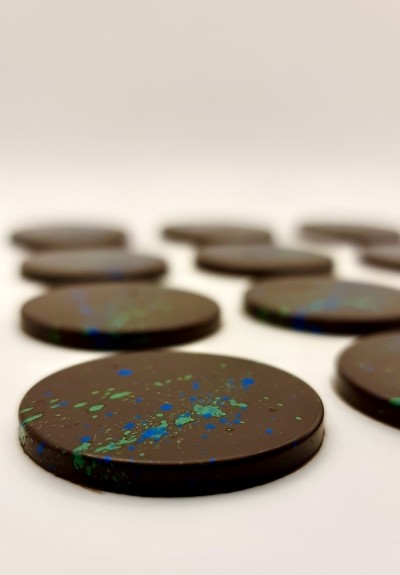 The start-up’s limited-release choc this are launching next week. Image source: WNWN“Pretty much anyone who likes the taste of chocolate should like our product,” said Pak.A box of WNWN’s limited-release choc thins will retail for around £10, ‘on par’ with the price range of premium chocolate. In the future, its mass market range with sit within the mass market price bracket of around £3-4, we were told.The B2C sales model is just the ‘first step’, however. Currently, it means WNWN can take a bigger role in educating shoppers and creating ‘fun products’. Once consumer demand is established, the business plans to expand into B2B ingredient sales.“We can supply our product in both chocolate mass and cocoa powder form, so that is the ultimate aim. Impact only comes with scale.” And WNWN doesn’t plan on stopping there. It is an ingredients company more than anything, the CEO suggested, and chocolate is only one product with problematic supply chains.“Chocolate is our first project, and then we’ll be moving into other products, such as coffee and vanilla.” .
The start-up’s limited-release choc this are launching next week. Image source: WNWN“Pretty much anyone who likes the taste of chocolate should like our product,” said Pak.A box of WNWN’s limited-release choc thins will retail for around £10, ‘on par’ with the price range of premium chocolate. In the future, its mass market range with sit within the mass market price bracket of around £3-4, we were told.The B2C sales model is just the ‘first step’, however. Currently, it means WNWN can take a bigger role in educating shoppers and creating ‘fun products’. Once consumer demand is established, the business plans to expand into B2B ingredient sales.“We can supply our product in both chocolate mass and cocoa powder form, so that is the ultimate aim. Impact only comes with scale.” And WNWN doesn’t plan on stopping there. It is an ingredients company more than anything, the CEO suggested, and chocolate is only one product with problematic supply chains.“Chocolate is our first project, and then we’ll be moving into other products, such as coffee and vanilla.” .

